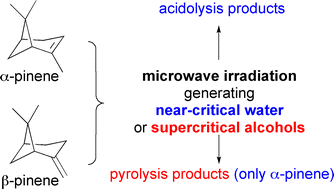Fate of monoterpenes in near-critical water and supercritical alcohols assisted by microwave irradiation†‡
Abstract
The rearrangement of α- and β-pinene was studied under microwave irradiation in near-critical

* Corresponding authors
a
Institute for Technical Chemistry and Environmental Chemistry, Friedrich-Schiller University Jena, Lessingstraße 12, Jena, Germany
E-mail:
Achim.Stolle@uni-jena.de
Fax: 49 3641 948402
Tel: 49 3641 948413
The rearrangement of α- and β-pinene was studied under microwave irradiation in near-critical

 Please wait while we load your content...
Something went wrong. Try again?
Please wait while we load your content...
Something went wrong. Try again?
T. Szuppa, A. Stolle and B. Ondruschka, Org. Biomol. Chem., 2010, 8, 1560 DOI: 10.1039/B924748C
To request permission to reproduce material from this article, please go to the Copyright Clearance Center request page.
If you are an author contributing to an RSC publication, you do not need to request permission provided correct acknowledgement is given.
If you are the author of this article, you do not need to request permission to reproduce figures and diagrams provided correct acknowledgement is given. If you want to reproduce the whole article in a third-party publication (excluding your thesis/dissertation for which permission is not required) please go to the Copyright Clearance Center request page.
Read more about how to correctly acknowledge RSC content.
 Fetching data from CrossRef.
Fetching data from CrossRef.
This may take some time to load.
Loading related content
